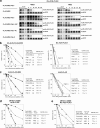Tethering of poly(A)-binding protein interferes with non-translated mRNA decay from the 5' end in yeast
- PMID: 20732870
- PMCID: PMC2962457
- DOI: 10.1074/jbc.M110.117150
Tethering of poly(A)-binding protein interferes with non-translated mRNA decay from the 5' end in yeast
Abstract
The decay of eukaryotic mRNA is triggered mainly by deadenylation, which leads to decapping and degradation from the 5' end of an mRNA. Poly(A)-binding protein has been proposed to inhibit the decapping process and to stabilize mRNA by blocking the recruitment of mRNA to the P-bodies where mRNA degradation takes place after stimulation of translation initiation. In contrast, several lines of evidence show that poly(A)-binding protein (Pab1p) has distinct functions in mRNA decay and translation in yeast. To address the translation-independent function of Pab1p in inhibition of decapping, we examined the contribution of Pab1p to the stability of non-translated mRNAs, an AUG codon-less mRNA or an mRNA containing a stable stem-loop structure at the 5'-UTR. Tethering of Pab1p stabilized non-translated mRNAs, and this stabilization did not require either the eIF4G-interacting domain of Pab1p or the Pab1p-interacting domain of eIF4G. In a ski2Δ mutant in which 3' to 5' mRNA degradation activity is defective, stabilization of non-translated mRNAs by the tethering of Pab1p lacking an eIF4G-interacting domain (Pab1-34Cp) requires a cap structure but not a poly(A) tail. In wild type cells, stabilization of non-translated mRNA by tethered Pab1-34Cp results in the accumulation of deadenylated mRNA. These results strongly suggest that tethering of Pab1p may inhibit the decapping reaction after deadenylation, independent of translation. We propose that Pab1p inhibits the decapping reaction in a translation-independent manner in vivo.
Figures








Similar articles
-
Multiple functions for the poly(A)-binding protein in mRNA decapping and deadenylation in yeast.Genes Dev. 1995 Oct 1;9(19):2421-32. doi: 10.1101/gad.9.19.2421. Genes Dev. 1995. PMID: 7557393
-
Accumulation of polyadenylated mRNA, Pab1p, eIF4E, and eIF4G with P-bodies in Saccharomyces cerevisiae.Mol Biol Cell. 2007 Jul;18(7):2592-602. doi: 10.1091/mbc.e06-12-1149. Epub 2007 May 2. Mol Biol Cell. 2007. PMID: 17475768 Free PMC article.
-
mRNA stabilization by poly(A) binding protein is independent of poly(A) and requires translation.Genes Dev. 1998 Oct 15;12(20):3226-35. doi: 10.1101/gad.12.20.3226. Genes Dev. 1998. PMID: 9784497 Free PMC article.
-
The Saccharomyces cerevisiae poly (A) binding protein (Pab1): Master regulator of mRNA metabolism and cell physiology.Yeast. 2019 Jan;36(1):23-34. doi: 10.1002/yea.3347. Epub 2018 Oct 17. Yeast. 2019. PMID: 30006991 Review.
-
Eukaryotic mRNA decapping.Annu Rev Biochem. 2004;73:861-90. doi: 10.1146/annurev.biochem.73.011303.074032. Annu Rev Biochem. 2004. PMID: 15189161 Review.
Cited by
-
Aspergillus oryzae AoSO is a novel component of stress granules upon heat stress in filamentous fungi.PLoS One. 2013 Aug 21;8(8):e72209. doi: 10.1371/journal.pone.0072209. eCollection 2013. PLoS One. 2013. PMID: 23991062 Free PMC article.
-
Nanopore Direct RNA Sequencing of Monosome- and Polysome-Bound RNA.Methods Mol Biol. 2023;2632:281-297. doi: 10.1007/978-1-0716-2996-3_20. Methods Mol Biol. 2023. PMID: 36781736
-
Roles of mRNA poly(A) tails in regulation of eukaryotic gene expression.Nat Rev Mol Cell Biol. 2022 Feb;23(2):93-106. doi: 10.1038/s41580-021-00417-y. Epub 2021 Sep 30. Nat Rev Mol Cell Biol. 2022. PMID: 34594027 Free PMC article. Review.
-
Roles of mRNA fate modulators Dhh1 and Pat1 in TNRC6-dependent gene silencing recapitulated in yeast.J Biol Chem. 2015 Mar 27;290(13):8331-47. doi: 10.1074/jbc.M114.615088. Epub 2015 Feb 5. J Biol Chem. 2015. PMID: 25657010 Free PMC article.
-
Trypanosome MKT1 and the RNA-binding protein ZC3H11: interactions and potential roles in post-transcriptional regulatory networks.Nucleic Acids Res. 2014 Apr;42(7):4652-68. doi: 10.1093/nar/gkt1416. Epub 2014 Jan 26. Nucleic Acids Res. 2014. PMID: 24470144 Free PMC article.
References
Publication types
MeSH terms
Substances
LinkOut - more resources
Full Text Sources
Molecular Biology Databases
Miscellaneous

